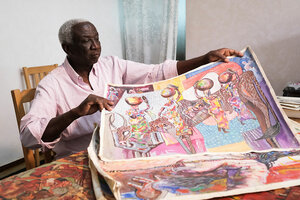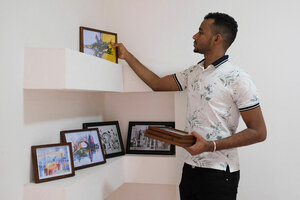‘Narrating our own story’: Amid war in Sudan, art lovers take a stand

Salah Abdel-Hay Fathallah, a retired assistant professor in art education at the University of Kordofan, holds an artwork at his rented house in Cairo, May 30, 2023. Along with other artists, he fled a war raging in Sudan, leaving behind more than 100 large canvases.
Fatma Fahmy/Reuters
Johannesburg
Afraa Ahmed left with nothing.
When the Sudanese artist fled her home in Khartoum, the country’s capital, in late April, bombs were already falling on her neighborhood. There wasn’t time to pack a suitcase, let alone make a plan for the dozens of paintings and ceramics she had scattered across her home and throughout the city’s galleries.
“I live for my art and I live by it,” she says of her life before a war that unexpectedly cleaved apart the lives of millions of Sudanese. Now, she can’t bear to paint. And even if she could, who would buy art in a time like this? “We all live every day in anxiety, tension, and fear,” she says from near the northern Sudanese city of Shendi, where she has temporarily found refuge.
Why We Wrote This
Creativity can be used to tell important stories in critical moments of history. Art lovers are fundraising to help Sudanese artists, uprooted and thrown into crisis by the war.
For Rahiem Shadad, a curator whose Khartoum-based space, Downtown Gallery, once displayed Ms. Ahmed’s works, such stories cut especially deep. “We formed to display the revolution’s art,” he says, referring to the 2019 movement that overthrew the three-decade dictatorship of former President Omar al-Bashir. “Since then, many of our artists have been able to completely devote their life to their art” for the first time, he says.
But the overthrow of Mr. Bashir’s authoritarian rule was followed by more than three years of political upheaval, which culminated in the fighting that began in April between Sudan’s army and a rival paramilitary force, both vying for political control.
Mr. Shadad wondered what these artists were going to do.
But instead of simply asking, he and his colleagues at Downtown Gallery decided to come up with an answer. They created Sponsor a Sudanese Artist, a crowdfunding site to collect money for artists, joining the grassroots movement of thousands of small-scale aid projects that have sprouted to assist Sudanese uprooted and thrown into crisis by the war. From university students rescuing people from areas under siege to neighborhood committees buying supplies in order to open clinics and replace the city’s shuttered hospitals, Sudanese have responded to the recent crisis with action.
“As Sudanese we realize our plight is not Ukraine, and it’s not the Notre Dame de Paris, where an old building burns and millions of dollars come out of nowhere to restore it,” says Azza Satti, a Sudanese curator based in Nairobi, Kenya, who was among the founders of Sponsor a Sudanese Artist.
But neither Ms. Satti nor Mr. Shadad dwelt long in that unfairness. Instead, they and their partners began reaching out to artists, asking them to fill out a Google form answering a basic question: What do you need?
The replies that came back were stark and simple. Food. Safe drinking water. To get my family out of Khartoum.
“We began to see how many people had fled with just the clothes on their backs,” Ms. Satti says. “And so we said, what can we do to help?”
Aiding artists felt especially monumental because Sudanese art was undergoing a renaissance. For the three decades that Mr. Bashir was president of Sudan, the country’s artists had worked in fear. His regime censored creative work and threw its dissidents into prison, forcing many artists into exile. But when a mass protest movement against Mr. Bashir’s regime ripped through the country in 2018 and 2019, visual art became its mouthpiece. “People expressed their politics with their brushes,” says Mr. Shadad.
Overnight, murals appeared on vacant walls and underpasses, depicting the movement’s martyrs and foot soldiers, and sometimes sharing the times and dates of protests. A social media movement, #BlueforSudan, resulted in people around the world changing their social media profiles to blue squares in solidarity with the country’s protesters.
“Artists are not just nice to have – they’ve been an integral part of the framing of the narratives of the democracy movement,” says Linda Bashai, an adjunct professor of international affairs at George Washington University who studies social movements in Sudan. “People were exploding with the desire to create. It’s a marker of the democratic movement that it draws on this creativity.”
Art is a language
Once Mr. Bashir was out of power, Mr. Shadad and his colleagues wanted to keep that artistic momentum going. Downtown Gallery, founded at the end of 2019, was the product. And from the start, the gallery’s goal was to create a space where Sudanese art could sustain itself.
“The idea [of Downtown Gallery] was always to have a space that’s self-sustained and not reliant on any foreign entity,” he says. “We wanted to be completely locally led and self-funded.”
And the plan had gone well. By 2023, the gallery worked with more than 60 Sudanese artists, both established and up-and-coming. In early April, it shipped a collection of Sudanese art curated by Mr. Shadad to Lisbon, Portugal, for an exhibition that would tour Europe.
Then, on the evening of April 14, Mr. Shadad’s colleagues closed and locked the gallery as they would on any other day, leaving hundreds of works of art inside. But they never returned. The following day, explosions tore through the neighborhood around the gallery, Khartoum 2. Fighting broke out between Sudan’s army and the Rapid Support Forces, the violent culmination of a rivalry between two of the country’s top generals. Downtown Gallery – like much of Sudan – was suddenly caught in the crossfire of war.
Since fighting began in mid-April, more than a million Sudanese have been displaced, and half the country’s population is now in need of urgent humanitarian assistance. To date, Sponsor a Sudanese Artist has collected more than $12,000, nearly all of which has already been dispersed to local artists, mostly via small grants of $100 to $500.
For now, the organizers say, people’s needs have largely been similar to those of Ms. Ahmed, who asked for help getting her family out of the path of bullets. But already, Sudan’s artists are beginning to express what they’re going through in their art.
Five hundred miles northeast of Khartoum, in Port Sudan, a collective of artists has begun organizing public art projects in which people can paint and listen to music to relieve stress. Other artists have started displaying art about the war on Instagram pages and other social media platforms.
“Throughout history, art is always this time stamp,” Ms. Satti says. “Art is a language to tell the stories of this moment. It’s a way of narrating our own story.”


